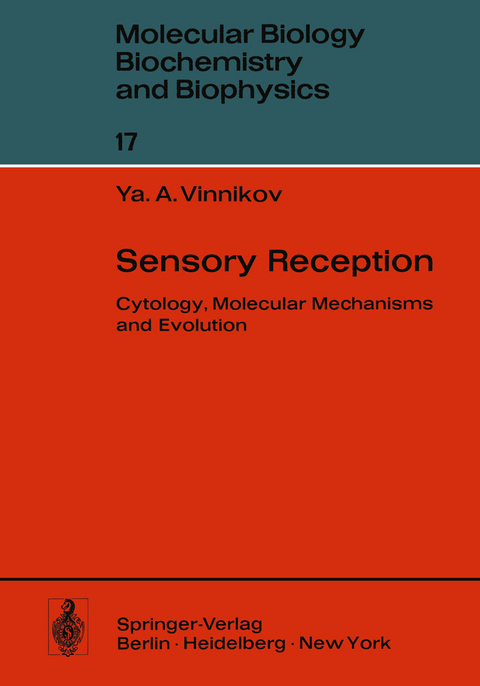
Sensory Reception
Springer Berlin (Verlag)
978-3-642-80824-1 (ISBN)
The Problem of Reception and the Evolution of the Cytological and Molecular Organization of Sense Organs.- I Structure and Development of Biological Membranes.- 1. Introduction.- 2. Structure and Chemical Composition of Membranes.- 3. Development, Differentiation and Growth of Membranes.- 4. Conclusion.- II Ultrastructural and Molecular Organization of Antennae.- 1. Introduction.- 2. Microvilli.- 3. Stereocilia.- 4. Flagella and Cilia (Kinocilia).- 5. Conclusion.- III Structural and Cytochemical Organization of Synapses.- 1. Introduction.- 2. Organization of Synapses.- 3. Synapses with Chemical Transmission.- 4. Ephaptic (Electrogenous) Synapses.- 5. Conclusion.- IV Vision.- 1. Introduction.- 2. Molecular Evolution of the Visual Pigment.- 3. Function of Rhodopsin.- 4. Development of the Visual Cell.- 5. Structural, Cytochemical and Functional Organization of Visual Cell.- 6. Conclusion.- V Taste.- 1. Introduction.- 2. Chemical Basis of the Action of Gustatory Substances and Theories of Taste.- 3. Sweet-Sensitive and Bitter-Sensitive Proteins.- 4. Structural Organization of Gustatory Receptor Cells of Vertebrates.- 5. Structural Organization of Contact Chemoreceptor (Gustatory) Sensillae of Insects.- 6. Cytochemical Organization of Taste Buds and Function of Taste Cells.- 7. Electrophysiological Investigations.- 8. Conclusion.- VI Smell.- 1. Introduction.- 2. Structure of Odorant Molecules. The Problem of Their Interaction with Olfactory Cells. Theories of Smell.- 3. Structural and Cytochemical Organization of the Olfactory Cells of Vertebrates.- 4. Functional Shifts of the Structural and Cytochemical Organization of Olfactory Cells in Vertebrates.- 5. Structural Organization of Olfactory Cells of Insects.- 6. Electrophysiological Investigations.- 7. Conclusion.- VII Hearing.- 1. Introduction.- 2. Auditory Stimulus, its Nonspecific and Specific Effect, and the Evolution of Auditory Receptor Mechanisms.- 3. Theories of Hearing.- 4. Structural and Cytochemical Organization of Hair Cells in the Organ of Corti in Birds.- 5. Structural and Cytochemical Organization of Hair Cells of Organ of Corti in Mammals.- 6. Structural Organization of Receptor Cells of Chordotonal Sensilla in Insects.- 7. Electrophysiological Studies.- 8. Conclusion.- VIII Gravity Reception.- 1. Introduction.- 2. Gravitational Stimulus.- 3. Evolution of the Structural and Functional Organization of the Gravireceptor of Unicellular, Invertebrate and Protochordate Organisms.- 4. Evolution of the Structural and Functional Organization of Gravireceptor of Vertebrates.- 5. Conclusion.- IX The Molecular Theory of Sensory Reception.- References.
| Erscheint lt. Verlag | 15.12.2011 |
|---|---|
| Reihe/Serie | Molecular Biology, Biochemistry and Biophysics Molekularbiologie, Biochemie und Biophysik |
| Übersetzer | W.L. Gray, B.M. Crook |
| Zusatzinfo | X, 394 p. |
| Verlagsort | Berlin |
| Sprache | englisch |
| Maße | 170 x 244 mm |
| Gewicht | 700 g |
| Themenwelt | Medizin / Pharmazie |
| Naturwissenschaften ► Biologie ► Evolution | |
| Schlagworte | Evolution • Evolution (Biol.) • Physiology • Rezeptor • Sinnesorgan • Sinnesphysiologie |
| ISBN-10 | 3-642-80824-7 / 3642808247 |
| ISBN-13 | 978-3-642-80824-1 / 9783642808241 |
| Zustand | Neuware |
| Haben Sie eine Frage zum Produkt? |
aus dem Bereich


